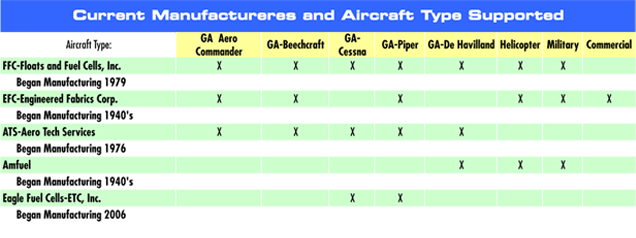
Are there different types of fuel cells?
Fuel is stored in aircraft in three different ways.
- Metal tanks - Placed in the cavity.
- Wet wing or integral tanks - Utilized in some general aviation aircraft but more prevalent in commercial aircraft. The cavity is sealed with urethane or polysulfide sealant to hold the fuel in the cavity.
- Bladders or Fuel Cells (such as Piper, Beech or Cessna fuel bladders) - Bladder is removable for repair. It holds the aircraft fuel in a collapsible tank in the event of damage to the cavity.
How are fuel cells manufactured?
Fuel cells are manufactured by combining two or more layers of material, creating an inner liner bonded to an outer liner. The inner layers should be non-porous and resistant to fuel vapors. The outer layer protects the cell from heat, ozone and humidity. The preferred material for bladder type fuel cells is vulcanized (autoclave cured) nitrile rubber compound. All fuel cells manufactured by FFC are autoclave cured nitrile rubber cells certified by the FAA.
How long do fuel cells last?
A new PMA fuel cell or even a properly repaired fuel cell by a certified repair facility should last you for many years - more than 20 years is not uncommon. But, it really depends on factors such as environment and operating conditions. A tank that is kept topped off with fuel is more likely to have a long life. Overhauled fuel cells can save you from 25% to 60% of the costs of a new fuel cell and when properly cared for, should perform as well as a new fuel cell.
What are the current technologies for manufacturing fuel cells, and which is approved by the FAA?
General Aviation: Three companies in the United States are currently manufacturing PMA replacement nitrile rubber fuel cells. Vulcanization is the only proven process for the manufacture of nitrile rubber fuel cells.
Vithane (Urethane) Cells: PMA replacement vithane fuel cells are currently manufactured only by Engineered Fabrics Corporation. (EFC)
Commercial Aviation: EFC is by far the largest manufacturer of commercial aircraft fuel cells using their Vithane technology. These tanks are prevalent in Boeing, and Douglass aircraft. The only other manufacturer competing in this market is American Fuel Cell and Coated Fabrics using nitrile rubber technology.
What methods might be used for fuel cell repairs, and does the FAA approve those methods?
Heat Cured Factory Repairs - Performed by factory-trained technicians. These would include Cessna fuel bladder repairs, Piper fuel bladder repairs and Beech fuel bladder repairs.
Air Cured Field Repairs - Approved by the FAA and the fuel cell manufacturer for emergency repairs. May be performed by A&P mechanics. Not recommended for permanent repairs - must be performed with manufacturer's approved materials and procedures. Repair kits not always available for construction types.
Coatings - Some approved by FAA. Performed with FAA authorization in an FAA approved CRS only. Not recommended.
Do-it-yourself - No approvals.
What is the proper use and care of aircraft fuel cells?
Fuel cell tanks should be topped off as much as possible to keep the fuel cell supple. Because fuel cells are adversely affected by extreme heat and humidity, hangar storage is best whenever possible. There are no inspection requirements for fuel cells. However, if a fuel cell is removed from an aircraft for any reason; it is wise to have it tested and inspected by a Certified Repair Station (CRS).
Why is it important to keep my aircraft in a hangar if possible?
Heat and humidity can cause fuel cells to dry out if the tanks are not topped off frequently. This drying out or brittle condition is one of the major causes of leaking fuel tanks. If you live in a particularly hot and humid climate, it is important to keep your fuel cells topped off if your aircraft is parked outside of the hangar for extended periods of time. Aircraft that are parked outside during the winter season are susceptible to accumulation of water in the tanks, which is a major cause of bladder failure.